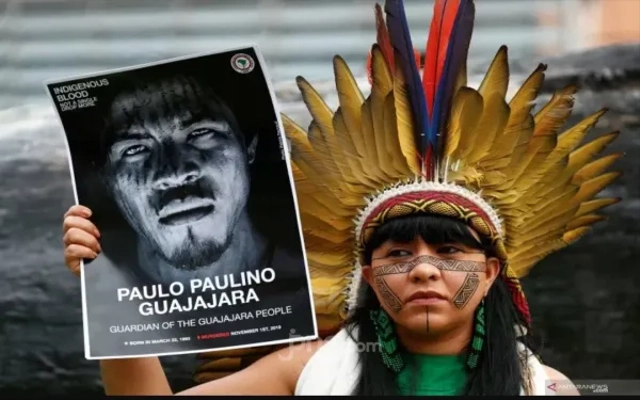Tentang KamiPedoman Media SiberKetentuan & Kebijakan PrivasiPanduan KomunitasPeringkat PenulisCara Menulis di kumparanInformasi Kerja SamaBantuanIklanKarir
2025 © PT Dynamo Media Network
Version 1.103.0
Konten dari Pengguna
Encouraging Social Inclusion For Indigenous Peoples
17 Juli 2021 20:19 WIB
·
waktu baca 7 menitTulisan dari Nurul Firmansyah tidak mewakili pandangan dari redaksi kumparan

ADVERTISEMENT
Indigenous peoples are social groups that have a strong relationship with nature. Nature is a living space as well as cultural and spiritual. This relationship with nature forms the unique and organic values, religiosity and culture of indigenous people. In addition, another characteristic of indigenous people is that these communities are mostly in remote areas and/or in forest areas.
ADVERTISEMENT
Root of Exclusion
Geographically distinctive and isolated ways of life result in indigenous peoples being socially isolated. This distinctive and remote way of life gives birth to negative prejudices in the form of stigmas from the wider community.
For example the nickname of silelek Kaulu with the hick or stupid connotation for remote indigenous communities that live upstream of the river in Mentawai, West Sumatra.
In the broader dimension, the bond between indigenous people and nature is a magical-religious dimension. This dimension is often interpreted as local wisdom, namely local values, knowledge and culture. The religious side of local wisdom is often interpreted as local beliefs or traditional (ancestral) religions.
ADVERTISEMENT
Problems arise when the magical-religious dimension interacts with mainstream religions. Dominant social groups still consider traditional religion and wisdom as a “deviance” from mainstream religion, so often stigma arises against indigenous people as deviant groups. This situation is reinforced by the current factor of religious conservatism which is getting thicker these days.
When explored more deeply, the social exclusion of indigenous people is a situation of rejection and ostracism in indigenous groups. Rejection of indigenous people, both individually and in groups, arises because their social identity is not desired by the wider community.
Whereas in the context of ostracism, it is a neglect of social relations toward individuals and groups of indigenous peoples who are considered as a dominant cultural deviation.
ADVERTISEMENT
Social exclusion of the community also affects their access to rights. Many cases show that indigenous people experience limited access to basic resources and services due to the situation of social exclusion that they experience along with the imbalance of political relations.
Accordingly, the situation of social exclusion of indigenous peoples resulted in them being isolated from political and social resources. This social and political isolation marginalized them from every political process and policy at the local level.
On the other hand, our legal framework still requires recognition of indigenous peoples as legal subjects by Local Government authorities.
The issue of social exclusion of indigenous peoples is both social and structural. The structural nature is related to the content of the policy and its implementation along with its procedures which have the potential to give birth to discrimination, violations and the neglect of rights by the state.
ADVERTISEMENT
On the other side, its social nature is the discrimination of indigenous peoples in strengthening social isolation in their relations with the wider community.
Social Inclusion
By definition, social inclusion is an approach that encourages the process of building social relations and respect for individuals and communities, so that those who are marginalized and experience prejudice can participate fully in decision making, economic, social, political, cultural life.
They also have equal access and control over resources (to meet basic needs) in order to enjoy welfare standards that are considered appropriate within the community group concerned.
The definition of social inclusion above includes two ways. First, it is a broad description to policy makers that social inclusion is processes of improving the requirements for marginalized groups to be able to take part (full participation) in society.
ADVERTISEMENT
Second, guideline to the community about fulfilling the requirements to increase social inclusion, and for whom. This means that social inclusion includes processes to increase the ability, opportunity and dignity of marginalized groups to gain recognition and take part in society.
The World Bank (2013) in the Inclusion Matters, the Foundation for Shared Prosperity states that inclusive society can be achieved through three areas: Market, Social Services, and Space. These three areas are interrelated with each other and also have obstacles as well as opportunities for social inclusion.
1. Market
Communities and individuals interact in the market including four elements; land, housing, labor, and credit. [1] In the context of indigenous people, the most important element in social inclusion is land in addition to the three other elements.
ADVERTISEMENT
This is related to the character of indigenous peoples who are generally agrarian communities and depend on land and natural resources. Land for indigenous peoples is a space which contains meaning as an asset as well as socio-cultural identity.
As an asset, land is a space where natural resources can be managed and collected by indigenous people, which then has an impact on labor absorption, the location of communal settlements (housing) and capital for the economic development of indigenous peoples.
Meanwhile, as a social and cultural identity, land is a space that contains the relations of tradition (custom) and the spirituality of indigenous peoples.
The issue of indigenous people’s access to land is one of the problems that still needs improvement. Our legal instruments have not fully provided full protection of indigenous people’s rights to land and natural resources due to the implementation of conditional recognition and agrarian sectoralism in agricultural affairs.
ADVERTISEMENT
On the other hand, however, the government has begun to open up indigenous people’s access to land and natural resources, even though it is sectoral, for example through social forestry and customary forestry programs in the forestry sector, and the registration program for communal customary lands in the land sector (outside the forest area).
The government has made these two programs main programs to address the issue of indigenous people’s access to land and natural resources as an important element in strengthening social inclusion.
2. Basic Services
Access to basic services is very important to increase social inclusion. Health and education services will improve human resources. Social protection services will provide cushioning for vulnerable groups, especially indigenous peoples against socio-economic shocks, and at the same time improve welfare.
ADVERTISEMENT
Transportation services increase mobility and connect individuals and communities with existing opportunities. Water and sanitation are very important for good health. Good service information will connect individuals and communities with basic service centers and provide opportunities to take part in economic activities. [2]
Many indigenous people still live in remote locations. They experienced geographical isolation, for example the indigenous people of Topo Uma in Central Sulawesi who experienced basic service constraints due to conditions of geographical remoteness.
In addition, indigenous peoples also experience social isolation due to distinctive cultural identities that are sometimes considered different or even deviated from the dominant (general) culture. For example the case of the Suku Anak Dalam in Jambi and West Sumatra that experience social isolation due to their cultural identity.
ADVERTISEMENT
3. Space
Physical space has social, political and cultural characteristics that encourage the process of exclusion. [3] Indigenous people often experience exclusion when more physical space is provided for dominant groups.
For example, many cases show that indigenous peoples experience coercion to get out of their living space (indigenous territories) due to the granting of business concessions for natural resource exploitation and also due to negative prejudices attached to them as forest encroachers, shifting cultivation and so on.
Social inclusion is also related to accountability. The marginal and poor status of indigenous people will add to the lack of access to political space. In many cases, political decisions are made without involving representatives from indigenous people.
ADVERTISEMENT
As a result, many indigenous people’s interests are not accommodated in decision making. In this context, the participation of marginal communities, especially indigenous people is the key to achieving inclusive communities.
Basically, development with an inclusion approach is how to create the prerequisites that realize the process of full involvement of marginalized groups.
In particular, indigenous peoples in development and policy making by respecting their rights, traditions (customs), culture and social identity, both individually and as a community. These inclusion processes work in the areas of markets, basic services and space.

